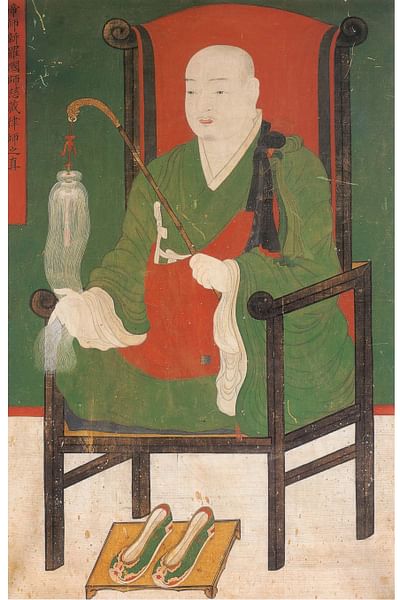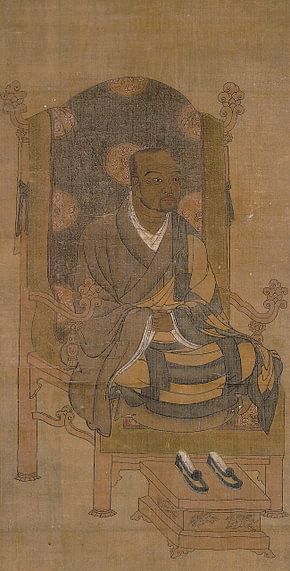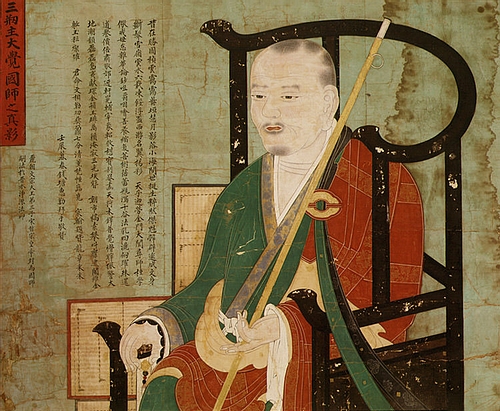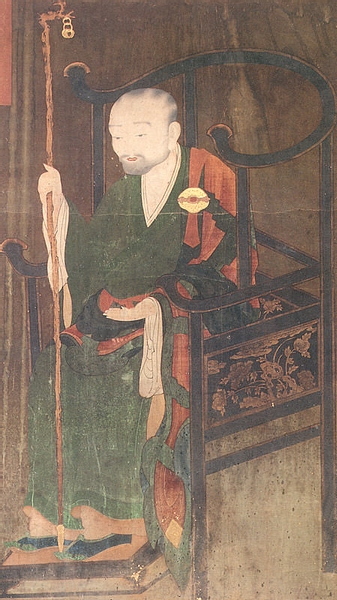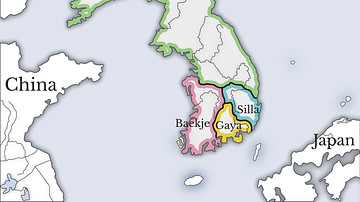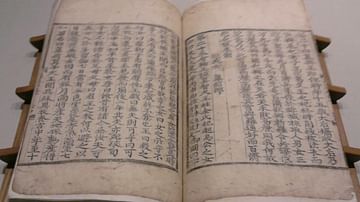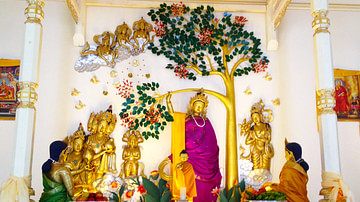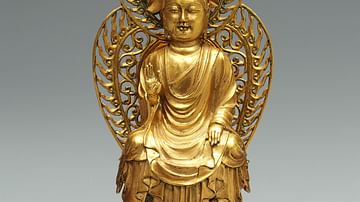Throughout ancient Korea's history Buddhist monks were a particularly important element of state and religious affairs. From the 4th century CE onwards, in the Three Kingdoms period, they were members of a select section of society which travelled and studied abroad, especially in China. Consequently, they were largely responsible for transmitting elements of Chinese culture into Korea and spreading the religious ideas they had acquired from studying under the great Chinese masters. Some of these monks would be founders of important and long-lasting sects of Buddhism, and a few would gain special favour at the royal courts of Korea, especially in the Silla kingdom which would go on to rule the whole of the peninsula. As advisors to kings, they would influence the acceptance of Buddhism and its continuation as the official state religion, and as the country's main scholars, they would have an immeasurable influence on literature and developments in printing and architecture. Below are short biographies of some of the most important of these figures.
Marananta
Marananta (aka Malananda or Malananta) lived in the 4th century CE and was a monk of Indian or Serindian origin who is credited with introducing Buddhism into the Korean peninsula. He came from the Eastern Jin state and taught Buddhism in the Baekje (Paekche) kingdom from 384 CE.
Ichadon
Ichadon (aka Geochadon/Kochadon) lived from 501 to 527 CE. His original name was Pak Yeomchok or Yeomdo, and he was a high court official of the Silla kingdom who managed to persuade King Beopheung to martyr him and so eliminate resistance to Buddhism. According to legend, when he was beheaded his blood flowed white and many other miraculous events occurred. As he had predicted, on his death, Buddhism came to be accepted.
Jajang
Jajang (aka Chajang) lived between 590 and 658 CE in the Silla kingdom. His given name was Seonjongnang and he was born, like many monks, into an aristocratic family. In 636 or 638 CE he went on a pilgrimage to the shrine of the bodhisattva Manjusri on Mt. Wutai in China, where he met a divine being, received some relics, and collected a great many Buddhist texts. The relics were of Buddha himself - a tooth, a piece of his skull, a patch of red silk robe he had worn, and 100 pearl beads (sariras) from his ashes. On his return to Korea in 643 CE, he founded the Vinaya school of Buddhism, one of the Five Schools (Ogyo), the most important school of Kyo Buddhism in ancient Korea.
Jajang also acquired the role of Chief Abbot of State and was given the task of supervising the spread of Buddhism in the Silla kingdom for which he created a system of inspection and standardisation for all monks and temples. In 645 CE he oversaw the construction of the famous nine-story pagoda at Hwangnyongsa (following the divine being on Mt. Wutai having promised it would permit Silla to destroy her enemies) and constructed the Tongdo Monastery where relics of the Buddha were enshrined.
Won Hyo
Won Hyo lived between 617 and 686 CE in the Silla kingdom, and he is the most famous of all Korean scholar-monks. After studying under many different masters, Won Hyo went to China to study more on Buddhism, but he abandoned his trip before he even got there. This decision was based on an experience one night in a cave when he drank from a cup by the light of the moon. In the morning he realised that the cave was, in fact, a tomb and the cup was a skull. Initially horrified, he then reasoned that his revulsion was only a state of mind and so he felt he had learned what he was searching for on his travels. On his return he wrote treatises on all the various Buddhist doctrines, assessing each one. He married Princess Yoseok with whom he had a son Seol Chong and founded the Dharma-nature (Popsang) sect. He spent the rest of his life travelling about the kingdom introducing Buddhism to the common people and spreading his message that a life of ascetic meditation was not necessary to reach nirvana. A prolific writer, he wrote more than 80 works.
Uisang
Uisang was another monk of the Silla kingdom who lived between 625 and 702 CE. Visiting China on a pilgrimage with Won Hyo in 650 CE, he travelled for 15 years, studying under the great Chinese Buddhist masters Zhiyan and Fazang. On his return to Korea Uisang founded the Hwaom School, another of the Five Schools, following his devotion to the Flower Garland Sutra (Hwaom-gyong). Uisang was noted for his strict discipline and adherence to ritual. Legend has it that he saved Silla from an invading army sent by Chinese emperor Tang Gaozong. The scholar's exposition of Hwaom thought, written in 661 CE, would become the basis of scholastic (scriptural) Buddhism in Korea. Uisang is also credited with founding the famed Buseoksa temple in Gyeongsangbuk-do Province, South Korea. One of Uisang's disciples was Simsang, who spread Hwaom Buddhism to Japan.
Pomnang
Pomnang lived between c. 632 and 646 CE. He travelled to Tang China and brought back with him the new to Korea doctrine of Son Buddhism, in China known as Chan and in the West as Zen (from the Japanese pronunciation), which stressed the importance of meditation and maintaining that it is the only path to enlightenment, as opposed to the study of religious texts.
Hyecho
Hyecho lived from 704 to 787 CE, again in the Silla kingdom, and once again he was a monk who studied in Tang China in 719 CE. There he met a teacher from India and was thus inspired to travel to that country himself. He reached India by sea in 723 CE and, after visiting many holy sites, returned via Kashmir, arriving at the Buddhist centre at Kucha in 727 CE. Hyecho recorded his travels and the cultures and customs he encountered in his 'Record of a Journey to the Five India Kingdoms' (Wango Chonchukkukchon).
Uicheon
Uicheon (aka Uichon or Taegak Kuksa) lived between 1055 and 1101 CE and was the fourth son of King Munjong of the Goryeo kingdom. Incredibly, he became a monk aged just 11. He studied for one year in China during 1085-6 CE at the Hwaom and Cheondae Schools and, on his return, attempted (but failed) to bridge the gap between the two major branches of Buddhism – the Seon and Kyo sects, which stressed the importance of meditation and scriptures respectively. The great scholar is said to have amassed a library of 5,000 books and he contributed a portion of the famous Tripitaka, a complete collection of all Buddhist scriptures, which was dedicated to indigenous texts from China, Japan, and Goryeo (Sok Changgyong). For his contribution to Korean learning he was made a National Teacher or kuksa in 1101 CE.
Doseon Guksa
Doseon Guksa (aka Toson, Yogong Seonsa or Yeongi Doseon) lived from 827 to 898 CE. According to legend, his mother swallowed a pearl and became pregnant with Doseon Guksa. He became a monk aged 14. Studying at various monasteries in the southern Cholla province, he visited Tang China c. 850 CE. On his return, he put his learning to good use, taught the principles of yin and yang, and was credited with founding the approach of pungsu (aka geomancy or feng shui in Chinese) in Korea.
Pungsu held that the location of homes, temples, graves and even cities should be carefully selected to take advantage of the symbolism and natural life forces thought to reside in such natural features as trees, rivers, and mountains. Further, the choice of a site could determine future good fortune and negative locations needed to be rebalanced with the construction of temples in order to avoid inauspicious events coming to pass. Using this approach, Doseon Guksa, as advisor to King Hongang, selected the best sites for countless monasteries and temples across southern Korea. His reputation was such that he was honoured as a great thinker by later kings like Taejo of Goryeo (r. 918-943 CE) who selected his capital of Gaeseong according to pungsu principles.
Jinul
Jinul (aka Bojo Chinul, Pojo Kuksa, or Chinul) lived from 1158 to 1210 CE, and he acquired a number of names over his lifetime including 'ox-tender' (Moguja) and 'universal light' (Pojo), with the former referring to the '10 ox pictures' of Buddhist art where the ox is a metaphor for Buddha. His title Pojo derives from the fact that, like Uicheon but with greater success, he tried to unite the two principal sects of Buddhism by stating that the meditation of the Seon way brought self-help and enlightenment but one should live daily by the principles of Kyo. His maxim was 'sudden enlightenment followed by gradual cultivation.' Jinul's unifying and inclusive form of Buddhism is known as Jogye Buddhism, and it became the official state religion of Korea with its centre at the Songgwangsa temple near modern-day Suncheon.
Jinul was also responsible for introducing to Korean Buddhism the technique of koans – unsolvable or nonsense problems – the contemplation of which was meant to result in flashes of enlightenment. Having lived all of his adult life in a monastery, he died in one too while he was giving a lecture. Jogye Buddhism continues to be the dominant form of Buddhism in Korea today.
This content was made possible with generous support from the British Korean Society.
